I’ve been growing black pines in colanders for years. Thanks to Bonsai Today issue #20 and Boon Manakitivipart, many enthusiasts have been doing the same. Sizes are convenient, drainage is great, and the cost is reasonable. I have yet to find pots that make it easier to keep black pines healthy.
In general, I’ve grown pines in colanders until the trunks reached the desired size. At this point, I’d transplant the trees into ceramic pots made for bonsai and get to work developing the branches.
I began to think twice about this approach after my recent visit to Mr. Iwakiri’s garden. Iwakiri keeps his pines in colanders throughout the entire development process. Based on his results, it’s hard to argue that more formal pots are necessary to produce outstanding bonsai.

Young black pine in colander
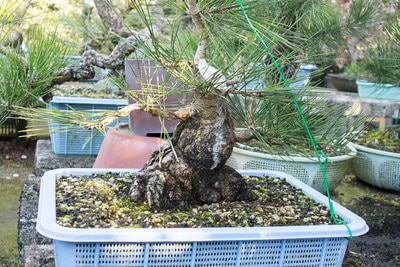
A slightly more developed pine
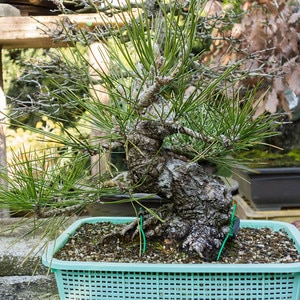
Even further development – the small-sized tree begins to take shape
What most stood out to me is the quality of the bark on some of the older trees. Container-grown pines can produce great bark.
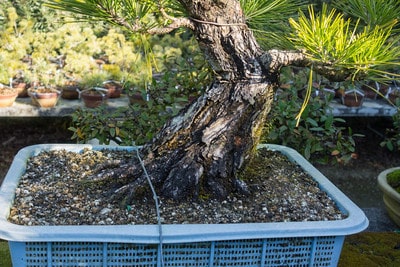
Great bark
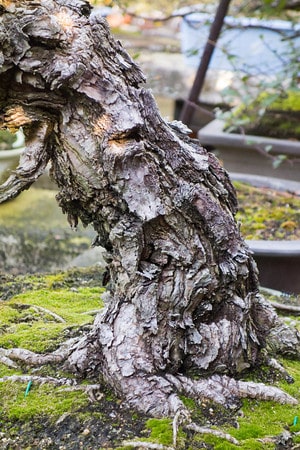
Interesting bark
I was also surprised to see how large some of the trees were in relation to the size of the colander. As long as the trees get enough water, a surprisingly small pot can support a lot of tree.
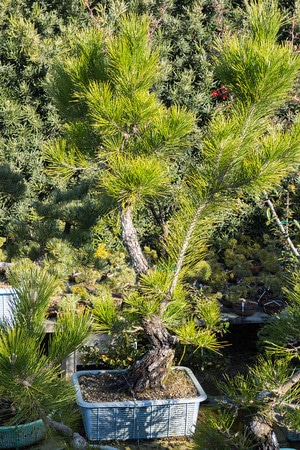
Large tree in colander
In the corner of Iwakiri’s garden was an almost 8′ pine in a surprisingly small colander. The colander sat in a saucer that held runoff from watering. Near the base of the saucer was a chopstick protruding from a small hole. During extended periods of rain, Iwakiri could remove the chopstick to prevent the roots from sitting in water for too long.
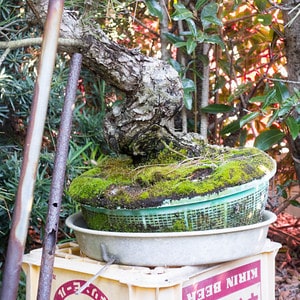
Colander-saucer-chopstick technique
The one colander-related technique of which I’m not a big fan is the double colander approach. Simply planting a tree – colander and all – into a larger colander is a simple and fast way to provide more space for roots with very little effort. Up until it’s time to repot anyway. Having clawed through thick roots and plastic fragments from the inner colander in the past, I prefer to remove the inner colander before setting the rootball in a new, larger, container.
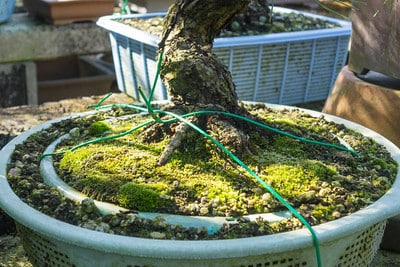
Double-colander technique
If all of this isn’t enough to trigger some curiosity about growing bonsai in colanders, I’ll finish with two last trees, each around 32 years old, developed by Iwakiri. Not bad for a hobbyist.
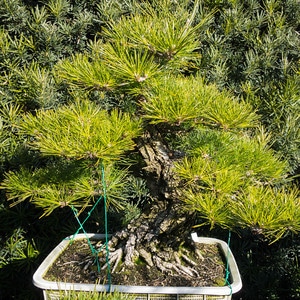
Black pine in colander
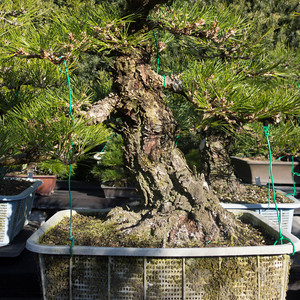
Black pine
Subscribe to Bonsai Tonight
New Posts Delivered Every Tuesday and Friday
paulkenni says
This is a great post, thanks! Two questions:
1. Traditional wisdom says you should grow trees in the ground for maximum growth rate, then reduce the roots and pot when you start branch development. Would you say that growing trees in colanders from seed inhibits that speed of growth, or not?
2. Would this be as effective for other conifers? And what about deciduous trees?
nelibonsai says
They use even 3 colanders in Japan. I have pictures.
Patricia Tatich says
Have you grown other types of trees in colanders to develop thicker trunks? Suggestions for northern NY?
Jonas Dupuich says
@Patricia – I’ve grown many kinds of trees in colanders and they seem to do well – the one thing to watch is that plants that like lots of water can dry out quickly in colanders. As winters are relatively warm where I live, I don’t have experience with them in frigid temperatures, though I’d expect trees planted in colanders require a bit more protection that trees planted in ceramic containers when it gets really cold.
@paulkenn – yes, trunk size will typically develop more quickly in the ground. The benefit of growing them in containers is that it makes it easier to guide the growth via periodic wiring and cutback that can be awkward when the tree is planted in the ground. I think the approach could be good for a number of varieties, coniferous or deciduous, but it is mostly seen for pines as they are a popular variety that grows quickly.
Shah says
Iv always wanted to use the basket for some of my pine I have some maples in them too and they grow great looking at this post well in sure il use them for the pines 🙂
V. Chamberlain says
We just added your RSS feed to cascadebonsai.org in southern Oregon. Love your blog!
Jim Gremel says
Thanks for another great post! I suggest trying Rootmaker pots and Accelerator pots. They are commercially available available black plastic pots, with many openings, that are designed to air prune roots. I have used them for years with many tree species. Two advantages over colanders: (1) they don’t degrade in full sun and (2) they are available in larger sizes (I use Accelerator pots in 3 gallon, 10 gallon and – I think – 25 gallon sizes.
Jonas Dupuich says
Thanks Jim, these are great – and thanks for sending photos!
http://dupuich.smugmug.com/Bonsai/General-Bonsai/i-zWm5SMT/A
http://dupuich.smugmug.com/Bonsai/General-Bonsai/i-XK4p7G3/A
Ben says
Awesome photos and a great story. Your blog recently convinced me to start putting my Black Pines in colanders. I am intrigued by the double colander technique and can understand the frustration of digging out the inner one. What do you think about using felt pots for the inner container? I know someone that does this with collected trees and is pretty succesful. Food for thought. Cheers!
Jonas Dupuich says
Hi Ben, interesting idea – if the roots can make their way from the felt through to the soil outside I’d expect the technique would work well. Another option is to set a felt pot or small colander on top of another container – or even directly on the ground. Anything that lets the roots grow unfettered will speed development.
Keith says
Hi Jonas,
when developing these powerful pines, are the final branches typically grafted on or maintained and trained from the beginning? thanks again
keith
owenbonsai says
Those blue containers may be for vegetable shipping. I washed a a few thousand crates of spinach every summer over there. That, or their version of an aquatic plant pot perhaps.
Keep fighting the good fight : ).
Owen
Sent from my iPhone
>
Timothy says
I have been thinking about planting in colanders for a while now, and I think this post has convinced me.
Thanks again!
Jonas Dupuich says
Hi Keith – it’s great to establish the final branches during development. These branches typically aren’t developed (ramified) until later in the process when the trunk reaches the desired size. When that’s not possible, grafting is the next best option.
vonsgardens says
Yet again another great post. Juan